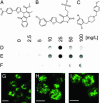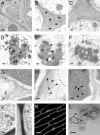Sorting inhibitors (Sortins): Chemical compounds to study vacuolar sorting in Arabidopsis
- PMID: 15190181
- PMCID: PMC439005
- DOI: 10.1073/pnas.0402121101
Sorting inhibitors (Sortins): Chemical compounds to study vacuolar sorting in Arabidopsis
Abstract
Chemical genomics is an interdisciplinary approach that unites the power of chemical screens and genomics strategies to dissect biological processes such as endomembrane trafficking. We have taken advantage of the evolutionary conservation between plants and Saccharomyces cerevisiae to identify such chemicals. Using S. cerevisiae, we screened a library of diverse chemical structures for compounds that induce the secretion of carboxypeptidase Y, which is normally targeted to the vacuole. Among 4,800 chemicals screened, 14 compounds, termed sorting inhibitors (Sortins), were identified that stimulated secretion in yeast. In Arabidopsis seedlings, application of Sortin1 and -2 led to reversible defects in vacuole biogenesis and root development. Sortin1 was found to redirect the vacuolar destination of plant carboxypeptidase Y and other proteins in Arabidopsis suspension cells and cause these proteins to be secreted. Sortin1 treatment of whole Arabidopsis seedlings also resulted in carboxypeptidase Y secretion, indicating that the drug has a similar mode of action in cells and intact plants. We have demonstrated that screening of a simple eukaryote, in which vacuolar biogenesis is not essential, can be a powerful tool to find chemicals that interfere with vacuolar delivery of proteins in plants, where vacuole biogenesis is essential. Our studies were done by using a sublethal dose of Sortin1, demonstrating the powerful ability of the chemical to control the induced phenotype in a manner that would be difficult to achieve using conventional genetics.
Figures




Similar articles
-
The yeast Saccharomyces cerevisiae is not an efficient tool for in vivo studies of plant vacuolar sorting receptors.Plant Cell. 2005 May;17(5):1339-42. doi: 10.1105/tpc.105.032276. Plant Cell. 2005. PMID: 15863520 Free PMC article. No abstract available.
-
Genomic screen for vacuolar protein sorting genes in Saccharomyces cerevisiae.Mol Biol Cell. 2002 Jul;13(7):2486-501. doi: 10.1091/mbc.02-01-0005. Mol Biol Cell. 2002. PMID: 12134085 Free PMC article.
-
Transmembrane nine proteins in yeast and Arabidopsis affect cellular metal contents without changing vacuolar morphology.Physiol Plant. 2010 Dec;140(4):355-67. doi: 10.1111/j.1399-3054.2010.01404.x. Physiol Plant. 2010. PMID: 20681974
-
Pumping up the volume - vacuole biogenesis in Arabidopsis thaliana.Semin Cell Dev Biol. 2018 Aug;80:106-112. doi: 10.1016/j.semcdb.2017.07.008. Epub 2017 Jul 8. Semin Cell Dev Biol. 2018. PMID: 28694113 Review.
-
Unique features of the plant vacuolar sorting machinery.Curr Opin Cell Biol. 2000 Aug;12(4):491-5. doi: 10.1016/s0955-0674(00)00121-6. Curr Opin Cell Biol. 2000. PMID: 10873819 Review.
Cited by
-
Chemical enhancers of posttranscriptional gene silencing in Arabidopsis.RNA. 2019 Sep;25(9):1078-1090. doi: 10.1261/rna.068627.118. Epub 2019 Jun 4. RNA. 2019. PMID: 31164480 Free PMC article.
-
Polar delivery in plants; commonalities and differences to animal epithelial cells.Open Biol. 2014 Apr 16;4(4):140017. doi: 10.1098/rsob.140017. Open Biol. 2014. PMID: 24740985 Free PMC article. Review.
-
An early secretory pathway mediated by GNOM-LIKE 1 and GNOM is essential for basal polarity establishment in Arabidopsis thaliana.Proc Natl Acad Sci U S A. 2015 Feb 17;112(7):E806-15. doi: 10.1073/pnas.1424856112. Epub 2015 Feb 2. Proc Natl Acad Sci U S A. 2015. PMID: 25646449 Free PMC article.
-
Composite synthetic lethal identification of membrane traffic inhibitors.Proc Natl Acad Sci U S A. 2007 Apr 10;104(15):6235-40. doi: 10.1073/pnas.0607773104. Epub 2007 Apr 2. Proc Natl Acad Sci U S A. 2007. PMID: 17404221 Free PMC article.
-
Molecular locks and keys: the role of small molecules in phytohormone research.Front Plant Sci. 2014 Dec 17;5:709. doi: 10.3389/fpls.2014.00709. eCollection 2014. Front Plant Sci. 2014. PMID: 25566283 Free PMC article. Review.
References
Publication types
MeSH terms
Substances
LinkOut - more resources
Full Text Sources
Other Literature Sources
Molecular Biology Databases

